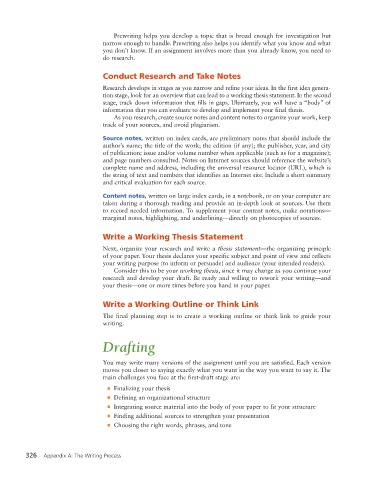Page 364 - Keys To Community College Success
P. 364
Prewriting helps you develop a topic that is broad enough for investigation but
narrow enough to handle. Prewriting also helps you identify what you know and what
you don’t know. If an assignment involves more than you already know, you need to
do research.
Conduct Research and Take Notes
Research develops in stages as you narrow and refine your ideas. In the first idea genera-
tion stage, look for an overview that can lead to a working thesis statement. In the second
stage, track down information that fills in gaps. Ultimately, you will have a “body” of
information that you can evaluate to develop and implement your final thesis.
As you research, create source notes and content notes to organize your work, keep
track of your sources, and avoid plagiarism.
Source notes, written on index cards, are preliminary notes that should include the
author’s name; the title of the work; the edition (if any); the publisher, year, and city
of publication; issue and/or volume number when applicable (such as for a magazine);
and page numbers consulted. Notes on Internet sources should reference the website’s
complete name and address, including the universal resource locator (URL), which is
the string of text and numbers that identifies an Internet site. Include a short summary
and critical evaluation for each source.
Content notes, written on large index cards, in a notebook, or on your computer are
taken during a thorough reading and provide an in-depth look at sources. Use them
to record needed information. To supplement your content notes, make notations—
marginal notes, highlighting, and underlining—directly on photocopies of sources.
Write a Working Thesis Statement
Next, organize your research and write a thesis statement—the organizing principle
of your paper. Your thesis declares your specific subject and point of view and reflects
your writing purpose (to inform or persuade) and audience (your intended readers).
Consider this to be your working thesis, since it may change as you continue your
research and develop your draft. Be ready and willing to rework your writing—and
your thesis—one or more times before you hand in your paper.
Write a Working Outline or Think Link
The final planning step is to create a working outline or think link to guide your
writing.
Drafting
You may write many versions of the assignment until you are satisfied. Each version
moves you closer to saying exactly what you want in the way you want to say it. The
main challenges you face at the first-draft stage are:
■ Finalizing your thesis
■ Defining an organizational structure
■ Integrating source material into the body of your paper to fit your structure
■ Finding additional sources to strengthen your presentation
■ Choosing the right words, phrases, and tone
326 Appendix A: The Writing Process

